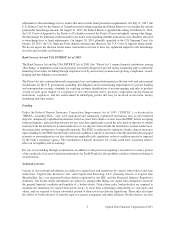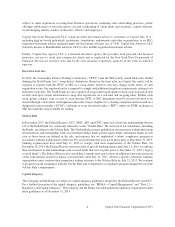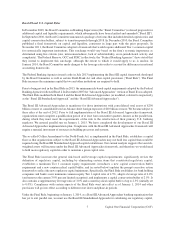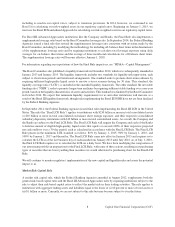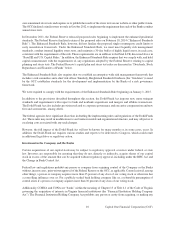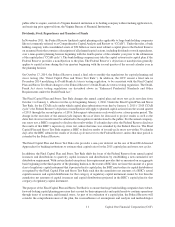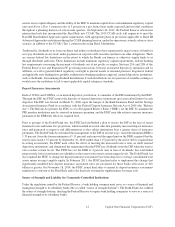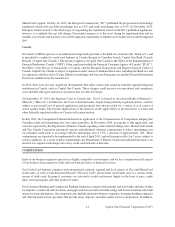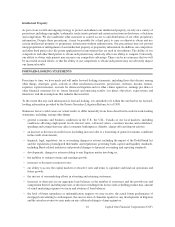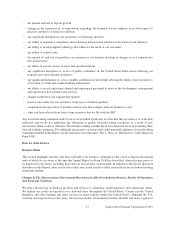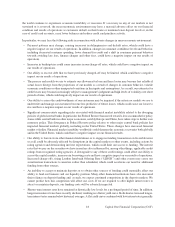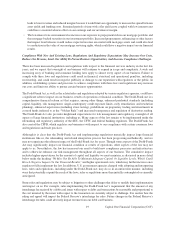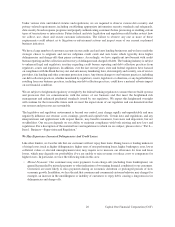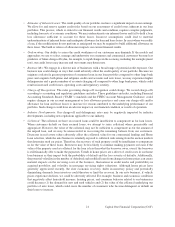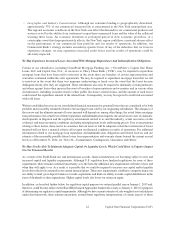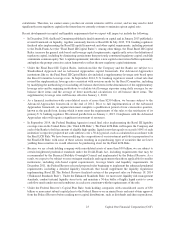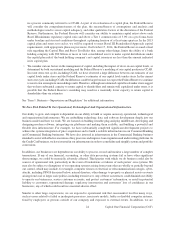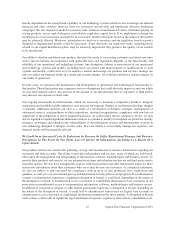Capital One 2014 Annual Report Download - page 37
Download and view the complete annual report
Please find page 37 of the 2014 Capital One annual report below. You can navigate through the pages in the report by either clicking on the pages listed below, or by using the keyword search tool below to find specific information within the annual report.
we compete against non-depository institutions that are able to offer these products and services. Securities firms and
insurance companies that elect to become financial holding companies may acquire banks and other financial
institutions. Combinations of this type could significantly change the competitive environment in which we conduct
business. The financial services industry is also likely to become more competitive as further technological advances
enable more companies to provide financial services. These technological advances may diminish the importance of
depository institutions and other financial intermediaries in the transfer of funds between parties. In addition, competition
among direct banks is intense because online banking provides customers the ability to rapidly deposit and withdraw
funds and open and close accounts in favor of products and services offered by competitors.
Our businesses generally compete on the basis of the quality and range of their products and services, transaction
execution, innovation and price. Competition varies based on the types of clients, customers, industries and
geographies served. Our ability to compete depends, in part, on our ability to attract and retain our associates and
on our reputation. In the current environment, customers are generally attracted to depository institutions that are
perceived as stable, with solid liquidity and funding. We believe that we are able to compete effectively in our
current markets. There can be no assurance, however, that our ability to market products and services successfully
or to obtain adequate returns on our products and services will not be impacted by the nature of the competition that
now exists or may later develop, or by the broader economic environment. For a discussion of the risks related to our
competitive environment, please refer to “Part I—Item 1A. Risk Factors.”
EMPLOYEES
A central part of our philosophy is to attract and retain a highly capable staff. We had approximately 46,000
employees, whom we refer to as “associates,” as of December 31, 2014. None of our associates are covered under
a collective bargaining agreement, and management considers our associate relations to be satisfactory.
ADDITIONAL INFORMATION
Technology/Systems
We leverage information technology to achieve our business objectives and to develop and deliver products and
services that satisfy our customers’ needs. A key part of our strategic focus is the development and use of efficient,
flexible computer and operational systems, such as cloud technology, to support complex marketing and account
management strategies, the servicing of our customers, and the development of new and diversified products. We
believe that the continued development and integration of these systems is an important part of our efforts to reduce
costs, improve quality and provide faster, more flexible technology services. Consequently, we continuously review
capabilities and develop or acquire systems, processes and competencies to meet our unique business requirements.
As part of our continuous efforts to review and improve our technologies, we may either develop such capabilities
internally or rely on third-party outsourcers who have the ability to deliver technology that is of higher quality, lower
cost, or both. We continue to rely on third-party outsourcers to help us deliver systems and operational infrastructure.
These relationships include (but are not limited to): Total System Services Inc. (“TSYS”) for processing services for
our North American and U.K. portfolios of consumer and small business credit card accounts, and Fidelity
Information Services (“FIS”) for the Capital One banking systems.
To protect our systems and technologies, we employ security, backup and recovery systems and generally require the
same of our third-party service providers. In addition, we perform, or cause to be performed, a variety of
vulnerability and penetration testing on the platforms, systems and applications used to provide our products and
services in an effort to ensure that any attacks on these platforms, systems and applications are unlikely to succeed.
Capital One, along with several other U.S. financial services providers, was targeted on several occasions with
distributed denial-of-service (“DDOS”) attacks from sophisticated third parties that succeeded, on a few occasions,
in temporarily limiting our ability to service customers through online platforms.
15 Capital One Financial Corporation (COF)


